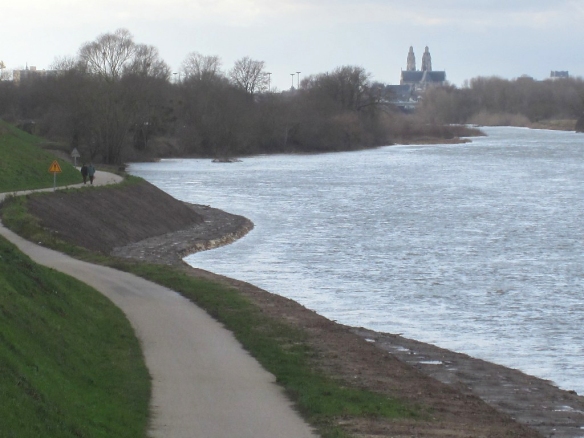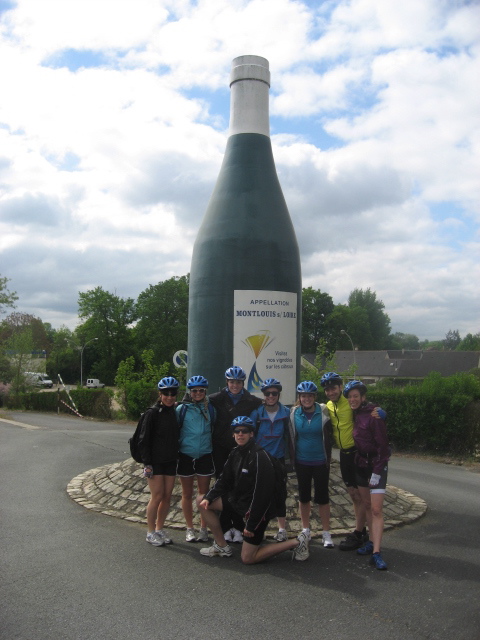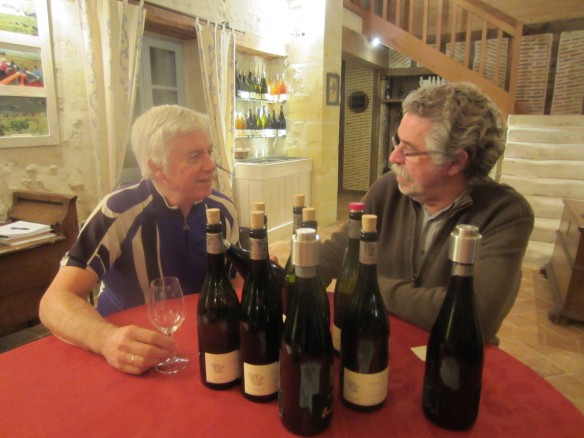Biking from Tours to Montlouis-sur-Loire
We all know the admonition that driving and alcohol don’t mix. I agree. It is equally important to understand, however, that biking and wine do mix. This is especially true in Touraine, where the quiet country roads through the vines present the cyclist with truly spectacular views, and where nothing is more wonderful than stopping at a vineyard to taste the local product, and discuss winemaking and wine with the winegrower.
The bike trip from Tours to Amboise is 32 km, or 64 km roundtrip. On this post we will bike to Montlouis-sur-Loire, through some lovely vineyards. Next week we continue on to Amboise. To see our route to Montlouis in Google Maps, click here.
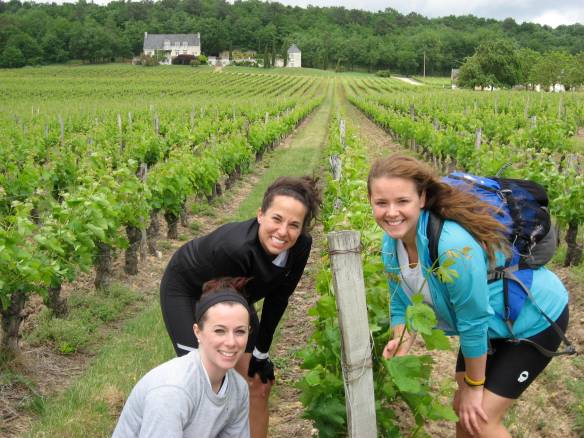
1. Three students on the 2007 University of Western Ontario student bike trip examine a Loire vineyard's progress in early May.
Beginning at the Tours train station, our bike route heads north to the Loire River, passing the St-Gatien Cathedral, where we pause in the square facing the church to admire the extraordinary facade. The cathedral was built over 300 years, from the 13th to the 16th century. The facade, with twin tours, similar but not identical, has a wonderfully harmonious feeling, despite the fact that it includes elements of Romanesque, Gothic, and Flamboyant Gothic architecture, all crowned with two lovely lanterns in the Renaissance style.

2. The 2010 University of Western Ontario alumni and friends bike trip in front of the St-Gatien Cathedral.
From St-Gatien we bike our way to the wide sidewalk, which also serves as a bike path, on the left bank of the Loire, heading east, and thus upstream. The road goes under the Autoroute 10 (Paris – Tours – Bordeaux) and leads us to the Loire à Vélo bike route, with no cars and beautiful views of the Loire.
On the opposite bank of the Loire are the cliffs of Rochecorbon, with troglodyte dwellings that include modern homes, restaurants, and a hotel. At one point we can see atop the cliff the Lantern of Rochecorbon, which once may have guided boats on the Loire but is now part of a private home.
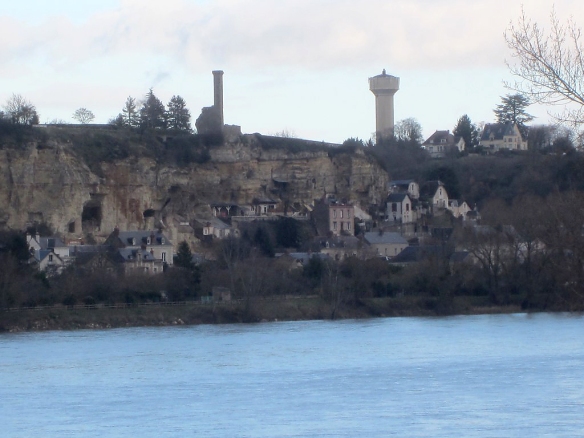
4. The Lantern at Rochecorbon, with troglodyte dwellings on the cliff side. The large structure on the right is a water tower.
As we approach Montlouis-sur-Loire, the bike route leaves the river valley, climbing to the levee on the left bank of the river. Nearby is a giant six meter wine bottle with a Montlouis-sur-Loire label.
Leaving the Montlouis bottle, we arrive in front of the Montlouis-sur-Loire City Hall. Across the street from the City Hall is a rest stop, the Bar Le Bugatti (02 47 50 90 40). We have gone 15 km.
From Montlouis we head east, entering a residential district with some large attractive houses behind impressive stone and concrete walls. The road runs east on the cliff above the river, and then turns south past a water tower (chateau d’eau), and then east into farmland, divided among pastures with beautiful horses grazing contently, and vineyards featuring the Chenin grapes of Montlouis wine. We are still on the Loire à Vélo bike trail, which will take us all the way to Amboise.
The Montlouis vineyards generally look south, turning their backs on the Vouvray district across the Loire River. Montlouis and Vouvray white wine are both made from Chenin grapes–no mixtures here with other varieties. If there is a grape that defines Loire wine, it is the Chenin, described by Hugh Johnson, the famous wine critic, as “the Loire’s own grape, the Chenin Blanc.” [1] While the history of the Chenin grape in the Loire Valley is a bit uncertain, it goes back over a thousand years.
Records dated 845 from the Glanfeuil Abbey (also known as the Saint Maur Abbey) indicate that Chenin blanc was grown on the left bank of the Loire at that time. The Benedictine abbey, thought to have been founded in the 6th century, was in the town of Le Thereuil, which sits in a lovely spot on the left bank of the Loire, midway between Angers and Saumur.
The Chenin grapes migrated east along the valley of the Loire and in the 15th century reached Touraine, where they are associated with Thomas Bohier (d. 1524) and his brother-in-law, Denis Briçonnet (1473-1535). Bohier built the Chateau de Chenonceaux, completed in 1521, and planted several varieties of grapes around the chateau. The Chenin thrived. After the death of Bohier, who was found to have embezzled a large sum of money from the Treasury, the chateau passed to King François I, whose son, King Henry II, adored the chateau’s Chenin wine.
Denis Briçonnet was the abbot of the monastery in Cormery, on the Indre River. He lived in the nearby Chateau de Montchenin, where he grew a wide variety of wines, including Chenin. A building was erected on this property in the 19th century which now serves as a medical clinic with the name Clinique du Chateau de Montchenain. Opinion is divided as to which of the two chateaux gave us the Chenin name: Chenonceaux or Montchenin.

7. A fork in the road on the west side of Montlouis. The Loire à Vélo bike trail goes left, as the sign in front of the tree indicates. The Montlouis vines surround the trail. It is Bastille Day, July 14, 2008, and the grapes are growing well.
Two great names in French literature, Francois Rabelais (d. 1553) and Honoré Balzac (1799-1850), are associated with the Chenin grape. No person in French history could have more credibility on wine drinking than François Rabelais, “who found the white wine of Ligré ‘like taffeta.'”[2] Ligré is about 60 km southwest of Montlouis, and the white wine in question was almost certainly from the Chenin grape (which, by the way, is no long grown in Ligré). In Rablais’ Gargantua, the Pricochole Wars near Chinon begin when the shepherds who are guarding ripe autumn grapes from hungry starlings are attacked by the bakers from a nearby town. The grapes are for wine, but they also delicious to eat. In Rabelais words, “grapes and fresh cake are a dish for the gods.”[3]
Rabelais goes on to list a variety of grapes, beginning with “pineau-grapes,” the name then for Chenin. The grapes even have medicinal properties–a young shepherd injured in the attack by the bakers has his legs “dressed … with big chenin grapes, so that they soon healed.”[4] Shortly after this initial skirmish, Friar John, of the nearby Abbey de Seuilly, courageously beats off the marauding neighbors in order to save the abbey vineyard. Wine is very important in Rabelais’ world.
Honoré Balzac consumed great volumes of Vouvray wine during his frequent visits to a chateau in Saché, south of Tours. It is said that his work routine at Saché involved consuming two or three bottles of Vouvray at dinner, then entertaining the company with imitations of his characters, before heading to his bedroom and working from midnight to 10 AM the next morning. Some of his characters also enjoyed Vouvray wine.
In 1938 Mountlouis-sur-Loire was established as a separate region from Vouvray by the authority of the AOC (Appellation d’Origine Controlée), which controls who can put a particular name on a bottle. The AOC acts as an agent of quality control, so that when you buy a Montlouis (or other AOC wine), you should know what are getting.
Back on our bike trip, we reach Husseau, on the east side of Montlouis. As we leave the vines we arrive at an intersection with a Loire à Vélo sign, with its distinctive image of a cyclist and wheels in white on a green background. One direction heads to Amboise, the other back to Montlouis and Tours.
Nearby we stop for a wine tasting at La Taille aux Loups vineyard. Late one afternoon, I had a fascinating visit with the winegrower, Jacky Blot, in a lovely wine tasting room on his estate. He is a cultured and articulate man, with a deep commitment to his profession. M. Blot spoke for 30 minutes on wine in general, and Loire wine in particular. He explained that he was not born to wine growing, but came to it through a passion for the activity (“Je ne suis pas originaire de la vigne. Je suis venu à la vigne par passion”).
For many years he worked as a wine broker, making the link between the growers and the buyers (wholesalers, retailers, restaurants). He then decided, in 1989, that what he really wanted to do was grow the wine himself, rather than taste and broker someone else’s wine. He currently farms 65 hectares (163 acres), producing 300,000 bottles of wine a year. His full-time team is 16 people; at harvest time (les vendanges) he will have 100 people in the fields.
M. Blot bought some good parcels in Montlouis, and began to grow his own wine with the Chenin grape, as required in Montlouis and Vouvray. He describes the Montlouis wine district as bounded by the Loire and Cher Rivers and the Amboise Forest, which long ago would have given his property its name. La Taille aux Loups can be translated as “the wood where the wolves gather,” as they would have done for centuries (they are gone now); la taille refers to a wood made up of small trees and underbrush. In 2002, he bought good winemaking land in Bourgeuil, about 60 km downstream on the right bank of the Loire, so that he could apply his wine making skills to a red Loire wine. The wines of the Domaine de la Butte are grown with the same attention to quality as the wines of Domaine de La Taille aux Loups.
M. Blot spoke at length of his philosophy of wine growing. I remarked that I have long felt that Loire wine is not sufficiently appreciated abroad, or even in France. He responded that wine regions become well known because of the elite growers who make the best wine, wine that is complex and takes great care in growing: the reputation of Bordeaux is based on the outstanding wine of just 10% of the land in vineyards, and for Burgundy, 20%.
His view of the Loire wines is that for the most part the region has not had such leaders in quality, and the wine estates have been content to produce simple wines that are good but not outstanding. Thus if Loire wines are not fully appreciated, it is the fault of the growers themselves. He sees his mission, and that of other growers who share his view, as establishing some truly outstanding Loire wines that will bring the reputation of the whole area to a new, higher level.
I asked M. Blot what makes a great wine. He said that the determinants of a great wine are widely known, the same for all regions of France, and for the most part unchanged for the last 100 years. You must begin with an outstanding terroir, a soil that has the right composition and drainage to produce a great wine. You then need to plant the right vines for that soil. If you have poor soil, or plant inferior vines, no amount of work or care thereafter will produce a great wine. Then comes the care of vines in a manner that respects nature: no pesticides, insecticides, or fungicides; a reasonable quantity of grapes per vine; hand picking at the right time under the right conditions.
Once the grapes are pressed at M. Blot’s vineyard, there are no adjustments, chemical or otherwise, made to the pure juice of the fruit: the wine is made on the vine and not in the cave (“le vin se fait dans la vigne, il ne se fait pas dans la cave”). A great fruit, and nothing else, makes a great wine, and that is true everywhere (“un grand fruit fait un grand vin, c’est ca et rien d’autre, et ca c’est vrai partout”).
M. Blot believes strongly that high quality wine is based on individual creative effort: he distinguishes “artisan wine” from “industrial wine,” the latter often involving the adjustment of the wine (e.g., adding an aroma) after the grapes are pressed. The artisan wine may be imperfect, but it has a natural taste which will have its place in a growing world wide market:
“We can hope that 1 or 5 or 10% [of wine consumers] will want to drink an artisan wine, authentic real wines, with their qualities and imperfections. I would rather have an artisan wine with a defect than an industrial wine with neither quality nor defects. I think those people will come [to the artisan wines]…. We Loire producers have an impressive future before us.” [4]
There is no shortage of laudatory opinion on M. Blot and his wine to be found among the wine critics. My favorite, because it captures both his commitment to quality and his pioneering sprit, goes like this: “Jacky Blot, at his domain since 1989, is upsetting only the conformist spirits of the Loire. Committed to excellence, this producer of charming Chenins is upsetting the rustic snoozing of the Bourgeuil cabernets.” [5]
Mme. Blot conducted the wine tasting with me, which included some of the bottles in Picture 9. I finally settled on a white 2009 Demi-Sec from the Domaine de la Taille aux Loups in Montlouis, and a red 2010 from the Domaine de la Butte in Bourgeuil. We have had our first bottle of each and they are outstanding. The red will improve with age over the next two or three years. While I loved the taste of Triple Zero natural sparkling (pétillant) Montlouis wine, I have a surplus of Loire sparkling wine at home. When my stock is down, I’ll be back to La Taille aux Loups for some Triple Zero
Suitably fortified, next week we will continue our bike ride east to Amboise, famous for its Royal Chateau and for the Kings who lived there.
[1] Hugh Johnson, The World Atlas of Wine, 4th edition, 1994, p. 114.
[2] Johnson, op. cit., p. 117.
[3] François Rabelais, Gargantua (Seuil, 1996), p. 213.
[4] Rabelais says that the young shepherd’s legs were dressed “avec gros raisins chenins.” Rabelais, op. cit., p. 216. Some English translations drop the reference to chenin grapes, which is unfortunate.
[5] “On peut espérer que 1 ou 5 ou 10% [des consommateurs] ont envie de prendre un vin d’artisan, authentique, des vins vrais, avec leurs qualités et leurs défauts. Moi je préfere un vin d’artisan avec des défauts à un vin d’industrie qui n’a ni qualité ni défaut. Je pense que ces gens la vont en venir [aux vins d’artisan]…. La Loire a un avenir impressionant devant nous.”
[6] “Jacky Blot, installé depuis 1989, ne dérange que les esprits conformistes de la Loire. Soucieux d’excellence, ce vinificateur de chenins charmeurs bouleverse le ronron rustique du cabernet bourgeuillois.” Le meilleurs vins de France.
Photograph 6 is from M. Blot’s website, jackyblot.fr. All other photographs were taken by the author or at his direction.

